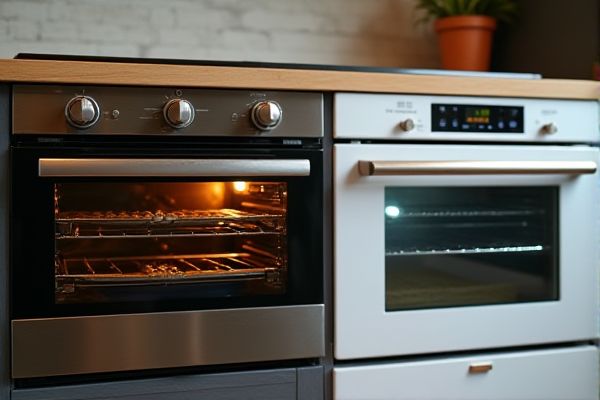
Convection ovens use a fan to circulate hot air, cooking food faster and more evenly, while conventional ovens rely on radiant heat from the top and bottom elements. Discover how choosing between convection and conventional ovens can elevate Your cooking experience by reading the rest of the article.
Table of Comparison
| Feature | Convection Oven | Conventional Oven |
|---|---|---|
| Heating Method | Fan circulates hot air evenly | Heat radiates from top and bottom elements |
| Cooking Time | Faster - reduces time by up to 25% | Longer cooking duration |
| Temperature | Typically set 25degF lower | Standard temperature settings |
| Cooking Results | Even baking, crispier textures | Uneven heating, less crispy |
| Best Uses | Roasting, baking multiple trays, dehydrating | Baking traditional recipes, broiling |
| Energy Efficiency | More energy-efficient due to shorter times | Less energy efficient |
| Price Range | Typically higher initial cost | Generally more affordable |
Introduction to Oven Technologies
Convection ovens utilize a fan and exhaust system to circulate hot air evenly, promoting faster and more uniform cooking compared to conventional ovens, which rely on radiant heat from stationary heating elements. This advanced technology enhances temperature consistency and reduces cooking times, making convection ovens ideal for baking and roasting. Understanding these differences helps you select the most efficient oven technology for your culinary needs.
What is a Convection Oven?
A convection oven uses a fan and exhaust system to circulate hot air evenly around the food, promoting faster and more uniform cooking compared to a conventional oven, which relies on radiant heat from the top and bottom elements. This efficient heat distribution helps reduce cooking time and allows for better browning and crisping, making it ideal for roasting and baking your favorite dishes. Understanding the difference can help you decide whether a convection oven suits your cooking needs and enhances your kitchen experience.
What is a Conventional Oven?
A conventional oven uses radiant heat from heating elements located at the top and bottom to cook food evenly throughout the cooking chamber. It relies on natural air circulation, which can result in slower cooking times compared to convection ovens. Conventional ovens are ideal for baking and roasting dishes that require steady, consistent heat without the movement of a fan.
Key Differences Between Convection and Conventional Ovens
Convection ovens use a fan to circulate hot air, resulting in faster and more even cooking, while conventional ovens rely on radiant heat from stationary heating elements. The key difference lies in heat distribution: convection ovens promote uniform temperature throughout the cavity, reducing cooking times and enhancing browning, whereas conventional ovens often have hot spots and longer heat-up periods. Understanding these differences helps you choose the right oven for consistent baking results or traditional roasting.
How Convection Ovens Work
Convection ovens use a fan and exhaust system to circulate hot air evenly around your food, resulting in faster and more uniform cooking compared to conventional ovens that rely on radiant heat. This airflow reduces hot spots and helps maintain consistent temperatures, enhancing baking and roasting performance. Understanding how convection ovens work allows you to optimize cooking times and achieve better results.
How Conventional Ovens Work
Conventional ovens use heating elements located at the top and bottom to cook food through radiant heat, creating a static cooking environment. Heat is transferred slowly and unevenly, often requiring higher temperatures and longer cooking times compared to convection ovens. Your dishes may experience hot spots and less even browning because the air inside a conventional oven remains relatively still.
Pros and Cons of Convection Ovens
Convection ovens use a fan to circulate hot air, resulting in faster and more even cooking, which is ideal for roasting and baking multiple trays simultaneously. They conserve energy due to reduced cooking times but may cause certain baked goods, like cakes and souffles, to dry out or cook unevenly without proper adjustments. While conventional ovens rely on radiant heat and offer more predictable results for delicate recipes, convection ovens excel in efficiency and browning, making them a preferred choice for many professional chefs and home cooks.
Pros and Cons of Conventional Ovens
Conventional ovens offer consistent heat through stationary heating elements, providing reliable results especially for baked goods that require steady temperatures like cakes and casseroles. However, they often result in uneven cooking or hot spots, which can lead to longer cooking times and less efficient heat distribution. Your choice of a conventional oven means benefiting from simplicity and familiarity but sacrificing the faster, more even cooking that a convection oven provides.
Which Oven is Best for Your Cooking Needs?
A convection oven uses a fan to circulate hot air, ensuring even cooking and faster bake times, making it ideal for roasting and baking multiple trays simultaneously. Conventional ovens rely on radiant heat from the top and bottom, providing consistent results for traditional recipes and foods requiring slow, steady cooking. Your choice depends on whether you need quick, uniform cooking or precise, traditional heat control for delicate dishes.
Conclusion: Choosing the Right Oven for Your Kitchen
Selecting between a convection oven and a conventional oven depends on cooking preferences and kitchen needs. Convection ovens offer faster, more even cooking using a fan to circulate hot air, ideal for roasting and baking multiple dishes at once. Conventional ovens provide consistent heat without airflow, making them suitable for delicate baked goods and recipes requiring steady temperatures.
 homyna.com
homyna.com